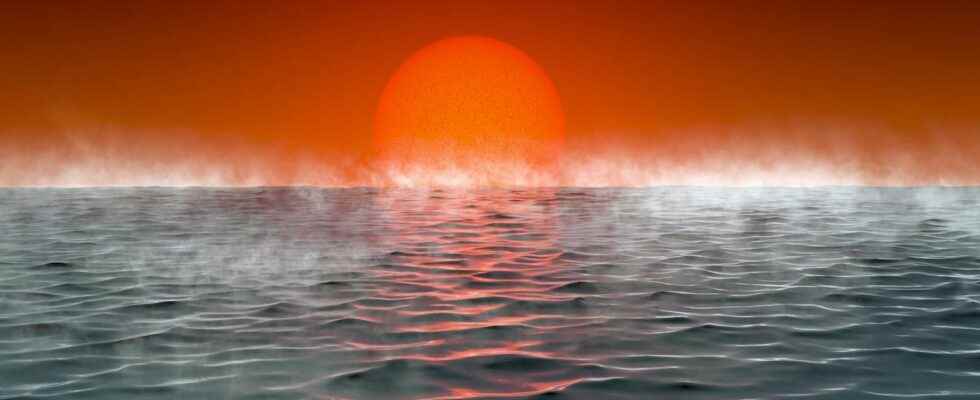You will also be interested
[EN VIDÉO] Exoplanets What are exoplanets, where are they found and why are they so interesting? Video answer!
The earth does gate not his nickname ” blue planet » for nothing: water covers nearly 72% of its surface. This gives it a special light signature, due to the reflection of the light by this water. How would distant observers see it? This is what researchers from the University of Delft and the Royal Netherlands Meteorological Institute wondered in a study published in the journal Astronomy & Astrophysics.
The study looked at the signatures lights of a planet that could characterize its ocean(s). For this, they modeled two “Earths”: one with a atmosphere dry, without water, and the other wet, similar to ours. They thus took into account the possibility of having, or not, different clouds : “ I‘hasabsorption of light in the planet’s atmosphere by gas H2O, O2O3CO2 and CH4 has been taken into account ». They then studied the path that light would make through these two planets before returning to an observer, and concluded that an ocean could generate a luminous signal characteristic of the polarization of light when it is reflected in the planet. ‘water.
Having an ocean would not be so rare for a planet
Having an ocean is fairly common, the researchers say, whether it’s on the surface, as with Earth, or deep down, as is likely the case with Europa, a satellite of Jupiter. In total, up to 25% of exoplanets known would shelter an ocean, according to them. But currently, the water on these stars is detected by spectroscopy, that is to say by analysis of the light emitted by the planet, when it passes in front of its star. It is possible thanks to this method to identify elements, therefore the presence of molecules of H2O, but not the way they are distributed: impossible then to formally identify a real ocean.
“Water vapor has already been detected in the atmospheres of planets extrasolar hot fizzy drinks. These detections were made using spectroscopy of transits of these planets and/or their eclipses secondary (when the planet moves behind the star) “, describes the study. But the new method proposed by the scientists is based on the observation of the light of the star which would be reflected by an ocean of water. liquid on an exoplanet.
Polarization as evidence of an ocean
In their study, the scientists calculated three elements in their numerical simulations ofexoplanets : the total luminous flux (F), the polarized flux (Q) and the degree of polarization (Ps) which corresponds to the ratio between Q and F. They then modeled the oceans so that they take into account all the reliefs due to movements of the waves and their consequences. ” The oceans are made up of reflective Fresnel surfaces with waves tossed about by the windof the’foam and shadows of waves, above natural blue sea water »they explain.
When starlight hits a liquid water oceanthen occurs what is called the “Fresnel reflection”. It occurs when light reflects in the same plane as the incident light. Also called parallel polarization, it takes its name from Augustin-Jean Fresnel, who made it possible to discover it. Researchers describe it as ” a thought mirror of the star in the water, called the reflection, which widens with the increase in the roughness of the surface of the ocean”.
And this is what they observed: their calculations showed that at “ wavelengths outside the bandsabsorption, the ocean reflection strongly increases F and |Q| with α increasing from 90°. The increase is caused by the increase in the local reflection angles on the ocean waves, and with this by the increase in the reflected light of Fresnel, giving a brighter glow”. They further observed that the degree of Ps polarization characteristically dips at the absorption bands only in the presence of an ocean! “Ps troughs are observed only for oceanic planets and only when the reflection is cloudless”, they enthuse. It would then be possible to reveal an ocean thanks to the measurement of polarization!
But, as they explain at the conclusion of their study, the telescopes current ones do not have a resolution sufficient to measure the polarized light reflected by exoplanets. Projects are underway, such as theEuropean Extremely Large Telescope (E-ELT) and the Large Ultraviolet Optical Infrared Surveyor (Luvoir), two telescopes being designed respectively by theESO and the Nasa : both will be able to detect the polarization of the light reflected by the exo-oceans.
Do you want to access Futura without being interrupted by advertising?
Discover our online subscriptions and browse without ads! At this moment, the Mag Futura is offered for a 3-month subscription to the subscription “I participate in the life of Futura”!
What is Mag Futura?
- Our first paper journal of more than 200 pages to make science accessible to as many people as possible
- A dive into the heart of 4 scientific themes that will mark 2022, from the Earth to the Moon
*Mag Futura is sent after the third month of registration.
Interested in what you just read?

